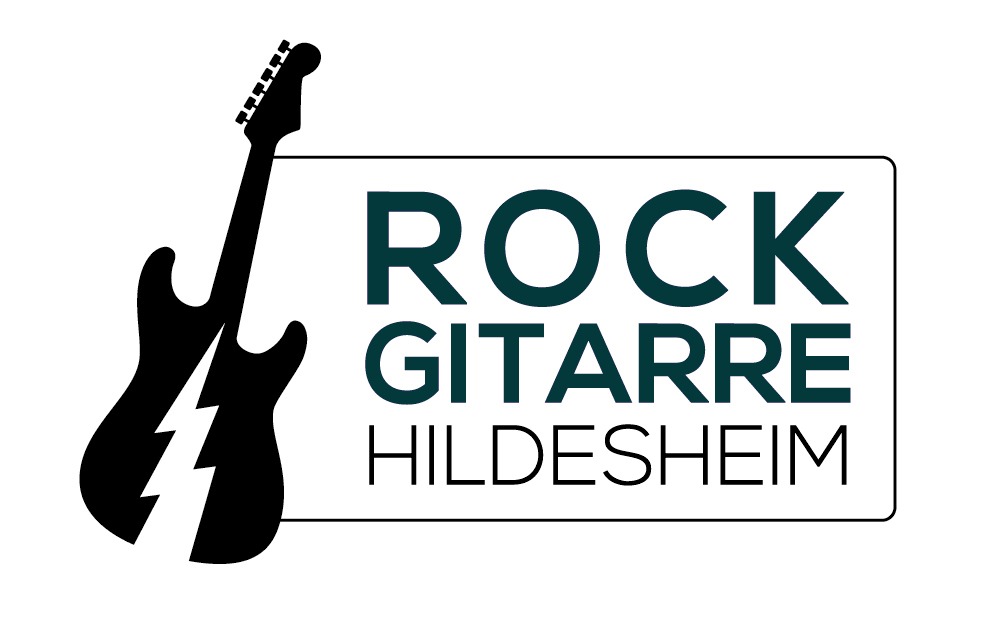by Dennis Winge
When you improvise over a chord progression, you can either address each chord as it passes in melodic line, or you can simply solo in the key that those chords are in. Addressing each chord is called “vertical” improvising simply because a chord is 3 or more notes, and although we often use a symbol to describe the note relationship (as in, for example, C7 to describe c, e, g, and bb), the notes of the chord, since they occur at the same time, are stacked on top of each other, as in the following.

If the chords were Gmaj7 and Am7, for example, then a ‘vertical’ improvised line might be something like:

The line emphasizes the chord tones of each chord, but also uses non-chord tones as well. This is as opposed a more ‘horizontal’ approach which means you’re soloing across the chord changes in the key of the song without worrying about the nuances of each chord in the progression. In the above example, horizontal thinking would just use the scale tones of the key of G (because this progression is | I | II | progression in the key of G), and might look something like this:
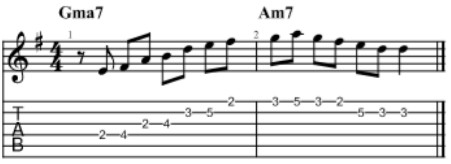
Neither horizontal nor vertical thinking is ‘better’ than the other, and you need both. When you think strictly horizontally, the advantage is that there’s potentially more of a melodic flow to your lines because you’re not being constricted by addressing the chords as they pass. The disadvantage, though, is that your lines are not benefiting from the changes in harmonic structure.
In the example above, there is a difference in harmonic character defined by the Am7 chord. It produces a different mood than the first chord. Horizontal improvising doesn’t address the subtle difference in chord changes within a key.
Going further, if the tune has ‘non-diatonic’ chords (ones that are outside the key) then horizontal improvising might land you some notes that clash with chords. Consider this example where the introduction of the F7 (a chord outside of G major) makes the e note (the 5th note of bar 2) clash with the notes of the F7 (which are f, a, c, and eb).
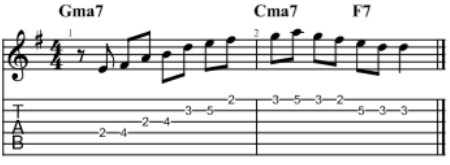
For many students, it’s easier to improvise horizontally because you’re just in a particular key and you don’t have to think as much, and to summarize, although horizontal thinking is melodic, it’s not harmonically well-informed. The ideal is to be both melodic and harmonically informed.
In order to think vertically, you must know how to ‘spell’ chords (which is a topic for another article), as I have done with the chords C7 and F7 above, and you must know how to play the chord arpeggios. An arpeggio is simply the notes of a chord played separately.
Using arpeggios in the example above might look something like this:
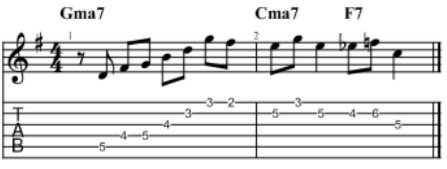
Every single note in the phrase is a chord tone. Clearly the advantage here is that the line is taking advantage of the harmonic changes within the key. The disadvantage is that putting too much emphasis on thinking vertically can impede the melodic flow of ideas. As mentioned, the ideal is to have both.
In the above example, suppose the line went:
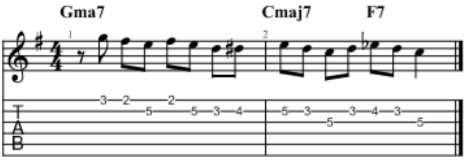
The thinking is G major, except we used eb instead of e over the F7 chord. We are blending horizontal and vertical thinking.
In order to do this well, you need to know both your arpeggios and your scales and be able to visualize the chord tones in your mind’s eye as you play the scales. For example, let’s choose the progression | D | A7 | which is a | I | V | progression in the key of D. You can play a D major scale over the whole progression, or you can arpeggiate each chord as it comes. But can you visualize which notes are the chord tones while you are playing the D major scale? An example could be:

This last step of integrating scales and arpeggios takes a while, but it is well worth it to make your lines sound melodically smooth and harmonically accurate. In many ways, this is the step that, once mastered, will completely transform your playing for the rest of your life. Whether it takes you a few or even many months, the return on investment is huge.
About the author: Dennis Winge is a professional freelance and studio guitarist, educator, and composer living in Ithaca, NY. His teaching website is Guitar Lessons Ithaca.
